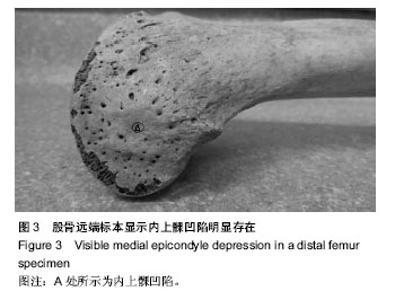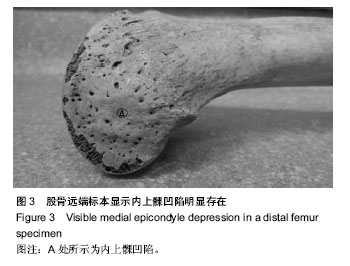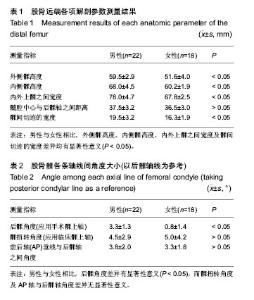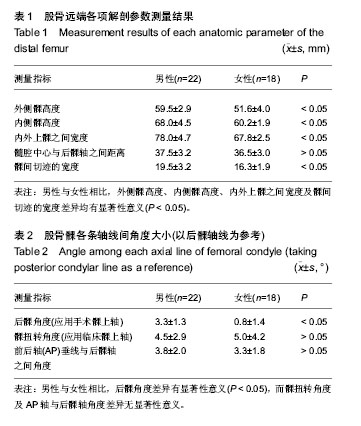| [1] 吴昊.全膝关节置换过程中的假体旋转对位[J].中国组织工程研究,2012,16(4):717-722.
[2] 洪源,冯建民,何川. 全膝关节置换术股骨假体旋转力线研究进展[J].国际骨科学杂志,2011,32(4):219-221.
[3] 戚盈杰,胡月正,吴剑彬,等. 全膝关节置换术股骨及胫骨假体旋转定位研究进展[J].国际骨科学杂志,2011,32(4):221-223.
[4] Berger RA, Rubash HE, Seel MJ, et al. Determining the rotational alignment of the femoral component in total knee arthroplasty using the epicondylar axis. Clin Orthop Relat Res. 1993;(286):40-47.
[5] 吴剑彬. 磁共振上股骨远端旋转力线的测量和股骨上髁的解剖研究[D].温州医学院,2009.
[6] Akagi M, Yamashita E, Nakagawa T,et al. Relationship between frontal knee alignment and reference axes in the distal femur. Clin Orthop Relat Res. 2001;(388): 147-156.
[7] 姜侃,吴巧云,巨啸晨.新疆哈萨克族全膝关节置换术(TKA)中股骨远端旋转对线方法的研究[J].新疆医学, 2013,43(9):20-25.
[8] 龙腾河,吕国顺,崔惠勤.磁共振图像测量膝关节置换股骨假体旋转对线[J].中国组织工程研究与临床康复,2011,15(52): 9839-9842.
[9] 纪小孟,刘皤,刘雅克,等.基于磁共振对股骨远端旋转参照轴线的确定及其临床意义[J].中华关节外科杂志:电子版,2012,6(3): 393-398.
[10] 孙辉红,陈益光,李晶,等.螺旋CT三维重建技术对股骨后髁角个体化测量的应用研究[J].中国CT和MRI杂志,2012,10(5):92-94.
[11] 窦鑫.范海建.张臻.等. 多排螺旋CT对股骨标本后髁角的测量及其临床意义[J]. 浙江临床医学, 2012,14(2):135-137.
[12] 臧越,吴舰,孙铁铮.膝关节骨性关节炎患者下肢扭转角度CT评价的临床价值[J].影像诊断与介入放射学,2012,21 (4):268-273.
[13] 张建雷,陆声,梁金龙,等. 基于连续断层CT扫描与三维重建技术的股骨远端旋转力线的测量[J].中国骨科临床与基础研究杂志, 2012,4(6):411-416.
[14] 陈识,关振鹏,张绍龙,等. 股骨后髁角与股骨假体旋转对线在人工全膝关节置换术中的应用[J].中华放射学杂志,2013,47(5): 470-471.
[15] 洪源,冯建民,何川,等. 股骨上髁轴与股骨外旋截骨角度的相关性研究[J].中华临床医师杂志:电子版,2013,7(14):6329-6334.
[16] 陈坚锋,冯宗权,罗璇.股骨后髁角测定仪的研制及在膝关节置换术中的应用[J]. 临床医学工程,2012,19(2):165-167.
[17] Sun T, Lu H, Hong N, et al. Bony Landmarks and Rotational Alignment in Total Knee Arthroplasty for Chinese Osteoarthritic Knees With Varus or Valgus Deformities. J Arthroplasty.2009;24(3):427-431.
[18] Van Der Linden H, Van Der Zwaag H, Konijn L, et al. The inter-and intra individual anatomical relationship of the femoral anteversion and distal femoral rotation .A cadaveric study on the femoral anteversion angle,posterior and interior condylar angle using computed tomography. J Bone Joint Surg Br. 2012;94-B:52.
[19] Arima J, Whiteside LA, McCarthy DS, et al. Femoral rotational alignment, based on the anteroposterior axis, in total knee arthroplasty in a valgus knee. A technical note. J Bone Joint Surg Am. 1995;77(9):1331-1334.
[20] Manili M, Muratori F, Fredella N. Whiteside line as the surgical landmark for femoral rotation in total knee arthroplasty. Radiological validation. Eur J Orthop Surg Traumatol. 2007; 17:599-602.
[21] 李军,李阳,荆珏华,等.华南地区正常成人股骨远端髁扭转角测量及其临床意义[J]中华关节外科杂志:电子版,2013,7(3):319- 322.
[22] 孙荣彬,王禹基,徐南伟.股骨滑车轴作为全膝置换股骨旋转截骨轴线的可靠性评估[J].中华创伤杂志,2012,28(2):243-246.
[23] Yoshino N, Takai S, Hirasawa Y, et al. Computed tomography measurement of the surgical and clinical trans epicondylar axis of the distal femur in osteoarthritis. J Arthroplasty. 2001; 16(4):493-497.
[24] Heyse TJ, Chong le R, Davis J,et al. MRI analysis for rotation of total knee components. Knee. 2012;19(5):571-575.
[25] Griffin FM, Math K, Scuderi GR, et al. Anatomy of the epicondyles of the distal femur: MRI analysis of normal knees. J Arthroplasty. 2000;15:354-359.
[26] Won YY, Cui WQ, Baek MH, et al. An Additional Reference Axis for Determining Rotational Alignment of the Femoral Component inTotal Knee Arthroplasty. J Arthroplasty. 2007; 22:1049-1053.
[27] 覃承诃,裴国献,罗吉伟.华南地区成人股骨后髁角及髁扭转角的MRI测量[J]. 南方医科大学学报, 2007,27(5):749-750.
[28] Luyckx T, Peeters T, Vandenneucker H, et al. Is adapted measured resection superior to gap-balancing in determining femoral component rotation in total knee replacement? J Bone Joint Surg Br. 2012;94-B:1271-1276.
[29] Oussedik S, Scholes C, Ferguson D, et al. Is Femoral Component Rotation in a TKA Reliably Guided by the Functional Flexion Axis? Clin Orthop Relat Res. 2012;470: 3227-3232.
[30] Amiri S, Wilson DR, Anglin C, et al. Isocentric 3-Dimensional C-Arm Imaging of Component Alignments in Total Knee Arthroplasty With Potential Intraoperative and Postoperative Applications. J Arthroplasty. 2013;28(2):248-254.
[31] Kaipel M, Gergely I, Sinz K, et al. Femoral Rotation in Ligament Balanced Knee Arthroplasty A Prospective Clinical Study. J Arthroplasty. 2013;282:1103-1106.
[32] Koninckx A, Deltour A, Thienpont E. Femoral sizing in total knee arthroplasty is rotation dependant. Knee Surg Sports Traumatol Arthrosc. 2013. Epub ahead of print.
[33] Moon YW, Seo JG, Lim SJ, et al. Variability in Femoral Component Rotation Reference Axes Measured During Navigation-Assisted Total Knee Arthroplasty Using Gap Technique. J Arthroplasty. 2010;25(2):238-243.
[34] Dennis DA, Komistek RD, Kim RH, et al. Gap Balancing versus Measured Resection Technique for TotalKnee Arthroplasty. Clin Orthop Relat Res. 2010;468:102-107. |



